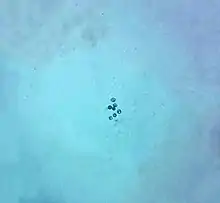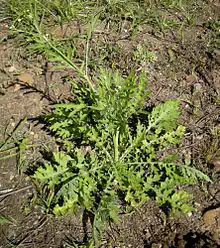Parthenium hysterophorus
Parthenium hysterophorus is a species of flowering plant in the aster family, Asteraceae. It is native to the American tropics.[1] Common names include Santa-Maria,[2] Santa Maria feverfew,[3] whitetop weed,[4] and famine weed.[5] In India, it is locally known as carrot grass, congress grass or Gajar Ghas.[6] It is a common invasive species[7] in India,[8] Australia, and parts of Africa.

| Parthenium hysterophorus | |
|---|---|
 | |
| Scientific classification | |
| Kingdom: | |
| (unranked): | |
| (unranked): | |
| (unranked): | |
| Order: | |
| Family: | |
| Genus: | |
| Species: | P. hysterophorus |
| Binomial name | |
| Parthenium hysterophorus | |
The pollen grains of Parthenium hysterophorus invades disturbed land, including roadsides. It infests pastures and farmland, causing often disastrous loss of yield, as reflected in common names such as famine weed.[9][10][11][12][13] In some areas, heavy outbreaks have been ubiquitous, affecting livestock and crop production, and human health.[14][15] As an invader it first appeared as a contaminant in imported wheat.[16]
The plant produces allelopathic chemicals that suppress crop and pasture plants, and allergens that affect humans and livestock. It also frequently causes pollen allergies.[17]
It is being investigated as a means of removing heavy metals and dyes from the environment, control of aquatic weeds, commercial enzyme production, an additive in manure for biogas production, as a biopesticide, and as green manure and compost.[18]
Toxicity

Contact with the plant causes dermatitis and respiratory malfunction in humans, and dermatitis in cattle and domestic animals. The main substance responsible is parthenin, which is dangerously toxic.[19][20][21] It also is responsible for bitter milk disease in livestock when their fodder is polluted with Parthenium leaves.[22]
Among other allelopathic effects of the species, the presence of Parthenium pollen grains inhibits fruit set in tomato, brinjal, beans, and a number of other crop plants.
Control


Light infestations of Parthenium hysterophorus in cultivated fields may be hoed or weeded by hand if labour is available at acceptable cost.
Generally the application of herbicides is expensive and often harmful; Paraquat sprays may be applied while the weeds are young. Glyphosate is not effective against this species.
The most satisfactory and promising means of practical long-term control are biological. Several species that feed on the weed are variously in use or on trial in various countries. The best-established control organism so far is a beetle native to Mexico, Zygogramma bicolorata, which was first introduced to India in 1984. It since has become widespread and well-established on the subcontinent. It defoliates and often kills the weed, and its damage to the young flowering tops reduces seed production.
In various countries, such as Australia and South Africa, several other biocontrol agents have been released or are under evaluation. These include at least two more species of beetles that have been released in South Africa, a stem boring weevil Listronotus setosipennis, and a seed weevil Smicronyx lutulentus.[23]
Also in South Africa, rust fungi have been of some use: the winter rust Puccinia abrupta var. partheniicola plus the summer rust Puccinia xanthii[23]
In Australia, apart from the foregoing, yet other biocontrol agents have been employed or evaluated on Parthenium hysterophorus, to a total of 11 species since 1980. Of those eleven, nine appear to have established in various regions. The two with the greatest effect seem to be the beetle Zygogramma bicolorata and a stem-galling moth Epiblema strenuana. However, other species that appear to have established usefully include a leaf-mining moth, Bucculatrix parthenica; a stem-galling weevil, Conotrachelus albocinereus; and a root-boring moth Carmenta ithacae.[24]
References
| Wikimedia Commons has media related to Parthenium hysterophorus. |
| Wikispecies has information related to Parthenium hysterophorus. |
- "Parthenium hysterophorus". Germplasm Resources Information Network (GRIN). Agricultural Research Service (ARS), United States Department of Agriculture (USDA). Retrieved 2010-10-29.
- "BSBI List 2007". Botanical Society of Britain and Ireland. Archived from the original (xls) on 2015-01-25. Retrieved 2014-10-17.
- "Parthenium hysterophorus". Natural Resources Conservation Service PLANTS Database. USDA. Retrieved 30 January 2016.
- "Parthenium hysterophorus". Integrated Taxonomic Information System. Retrieved 2010-10-29.
- McConnachie AJ, Strathie LW, et al. Current and potential geographical distribution of the invasive plant Parthenium hysterophorus (Asteraceae) in eastern and southern Africa. Weed Research. 2011 51(1) From http://www.farmersweekly.co.za 27 December 2013
- Oudhia, P., Tripathi, R. S., Choubey, N. K., & Lal, B. (2000). Parthenium hysterophorus: a curse for the bio-diversity of Chhattisgarh plains of MP. Crop Research (Hisar), 19(2), 221-224.
- "Parthenium hysterophorus (herb)". Global Invasive Species Database. Invasive Species Specialist Group. Retrieved 2010-10-29.
- Oudhia, P. (2000). Parthenium hysterophorus : a new weed in upland rice fields of the Chhattisgarh Plains (India).International Rice Research Notes (IRRN).25.1:34.
- Oudhia, P (2000). "Allelopathic effects of Parthenium hysterophorus and Ageratum conyzoides on wheat var.Sujata". Crop Research. 20 (3): 563–566.
- Oudhia, P (2000). "Positive (inhibitory) allelopathic effects of Parthenium hysterophorus leaves on germination and seedling vigour of sunflower". Crop Research. 20 (3): 560–562.
- Oudhia, P (2001). "Allelopathic effects of leachates and extracts of different parts of an obnoxious weed Parthenium hysterophorus L. on germination and seedling vigour of selected crops". Ecol. Env. And Cons. 7 (4): 427–434.
- Oudhia, P. and Tripathi, R.S. (1998). Allelopathic effects of Parthenium hysterophorus L. on Kodo, Mustard and problematic weeds. Proc. First International Conference on Parthenium Management (Vol. II) UAS, Dharwad 6-8 Oct. 1997: 136-139.
- Oudhia, P.; Kolhe, S.S.; Tripathi, R.S. (1997). "Allelopathic effect of Parthenium hysterophorus L. on germination of Linseed". Indian J. Plant Physiol. 2 (4): 327–329.
- Gebeyehu, Adane Kebede (2008). The distributions of parthenium weed (Parthenium hysterophorus L. Asteraceae) and some of its socio-economic and ecological impacts in the Central Rift Valley, Adami Tulu-Jido Kombolcha Woreda; Ethiopia (PDF) (M.Sc. thesis). Addis Ababa University. Archived from the original (PDF) on 2011-10-07. Retrieved 2009-03-13.
- "Deadly weed invaded Uganda". 2009-03-13. Archived from the original on 2009-03-16. Retrieved 2009-03-13.
- Dipankar De; Rashmi Jindal and Amrinder J Kanwar (2010). "Contact dermatitis to parthenium simulating lichen nitidus". Indian Journal of Dermatology, Venereology and Leprology. 76 (3): 286–287. doi:10.4103/0378-6323.62978. PMID 20445305.
- Kher, Prateek (2008-09-25). "Transforming an obnoxious weed into gold!". Merinews.
- Patel, S (2011). "Harmful and beneficial aspects of Parthenium hysterophorus: an update". 3 Biotech. 1 (1): 1–9. doi:10.1007/s13205-011-0007-7. PMC 3339593. PMID 22558530.
- CID 442288 from PubChem
- Parthenium
- "Integrated weed management for parthenium". The Hindu. Chennai, India. 2003-12-04.
- "Campaign launched for biological control of a dangerous weed". The Hindu. September 4, 2005.
- ARC-PPRI Fact Sheets on Invasive Alien Plants and their Control in South Africa|
- CRC for Australian Weed Management: Best Practice Guide. Impact evaluation of weed biological control agents 2008|